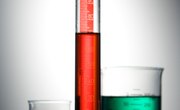
Algebra is a mathematical method used to calculate unknown values. Variables, which are generally represented by a letter of the alphabet, represent unknown values in an equation. Isolating the variable determines its value. Algebra is part of the high school math curriculum but also applies to many real-life situations. For example, calculating the value of a total from a known percentage is a valuable tool for determining the total number of voters in an election or calculating the total salary based on a percentage raise.
- Paper
- Pencil
- Calculator (optional)
Cross-multiplication is a shortcut that combines two steps of the algebraic solution process. Cross-multiply 2 ÷ 100 = 80 ÷ x to create 2x = 8000. This provides the same result as multiplying the entire equation by the product of the denominators, 100 and x. Come up with a common denominator then reduce the equation to its lowest terms.
To determine totals from a percent in the future, multiply the given percentage value by 100 and divide that product by the percent. This method works in any instance where a percentage and its value are given. For example, when 2 percent = 80, multiply 80 by 100 and divide by 2 to reach 4000.
Percentages may be written as fractions or decimals. For example, 2 ÷ 100 = 0.02.
Understand the meaning of percentage. The word percent comes from a Latin word meaning "for each 100." A percentage is essentially a fraction, with a denominator of 100. For example, 2 percent is equal to 2 ÷ 100, or 2 for each 100.
Note the value of the percentage. For example, if 2 percent = 80, know that 2 for each 100 is the same as 80 for each of the unknown value.
Create an equation that shows the fractional relationship between the percentage and its value. Use the variable x to represent the unknown total. In this case,
Cross-multiply the equation to bring the variable to one side of the equation as a whole number. Multiply values diagonal from each other in the equation, i.e.,
to create the whole number equation of
Divide both sides of the equation by the coefficient, 2. On the left side:
On the right side
The resulting equation is
Check your work by introducing the value of x into the original equation,
Replace x with 4000 and solve both sides of the equation to ensure that it balances. Use a calculator or sheet of paper to show that
Things You'll Need
Tips
References
Tips
- Cross-multiplication is a shortcut that combines two steps of the algebraic solution process. When 2/100=80/x is cross multiplied to create 2x=8000, it is the same result as multiplying the entire equation by the product of the denominators, 100 and x, to come up with a common denominator and then reducing the equation to lowest terms.
- The steps outlined in the algebraic solution for percentage totals allow you to derive a simple method for determining totals from a percent in the future. Multiply the given percentage value by 100 and divide that product by the percent. This method will work in any instance where a percentage and its value are given. For example, when 2%=80, multiply 80 by 100 and divide by 2 to achieve the solution of 4000.
- Percentages may be written as fractions or decimals. For example, 2/100=0.02
About the Author
Heather Lacey is a freelance writer who has been specializing in print and Web articles since 2008. She is a regular contributor to "Go Gilbert!," "Scottsdale Health Magazine" and other local publications. Lacey has a professional background in hospitality management and studied journalism at Phoenix College.
